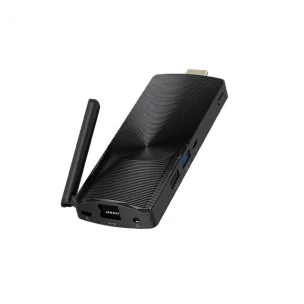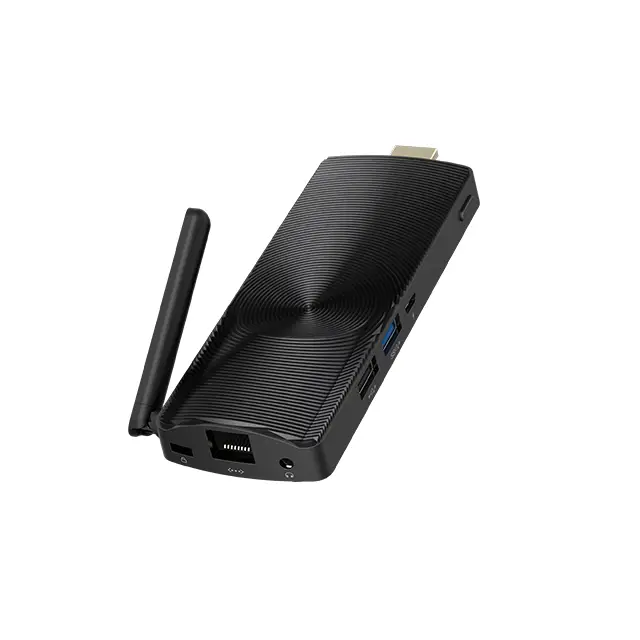Azulle Access Plus Review

The Azulle Access Plus is a good follow up from the strong showing of the byte plus, packing the same SOC inside a smaller package, it’s still a very well balanced mini pc. Powered by a midrange Atom x5-Z8300 it should still prove up to common tasks even with it’s reduced size. I was sent is an upscale model with 4gb lpddr3, Something that I think is a necessity for any type of multitasking in this day and age of memory gobbling browsers. But is overkill for two of the more attractive use cases for the stick like form factor that the access plus inhabits(but a little extra ram never hurts)
Specs
| Baseline | As reviewed | |
|---|---|---|
| Cpu | Atom x5-Z8300 | Atom x5-Z8300 |
| Memory | 2Gb | 4Gb |
| Storage | 32GB emmc | 32GB emmc+128gb microSD |
| Audio | Combo in/out 3.5mm | Combo in/out 3.5mm |
| Networking | Axxis usb2 Fast ethernet | Axxis usb2 Fast ethernet |
| Intel 3160 Dual band AC wireless | Intel 3160 Dual band AC wireless | |
| Ports | 1 usb 3.0 | 1 usb 3.0 |
| 1 usb 2.0 | 1 usb 2.0 | |
| 1 HDMI | 1 HDMI | |
| 1VGA | 1VGA | |
| 1 Fast Ethernet | 1 Fast Ethernet |
Changes
As with the Byte plus the system was augmented the same Samsung 128gb microSD card(which we reviewed here) for the duration of testing due to the Size of some of the applications used to reduce install/uninstall cycles required, this is a relatively inexpensive addition to a system such as this and a usb 3 device like the sandisk cruzer fit would also fulfill the same role(perhaps slightly quicker) although would consume a usb 3.0 port. For many of the use cases of a system like this however the additional storage is not required.
Performance
Performance is even more impressive considering the reduced surface area compared to the byte plus taking a look at geekbench 3, we see the same lead over older atom systems like the 330, and a maintain our lead over other similar systems like a Gen2 compute stick, and mixed results compared to a core2 duo laptop I have on hand showing worse single thread but a solid boost to multi threaded performance thanks to the presence of four cores, Everything falls behind a newer core i5 however. The results against the older core 2 duo are even more impressive considering that they’re being reached at a 600mhz deficit.
Storage performance was, a bit of a mixed bag, as with most systems in this segment the access plus uses eMMC, the same Toshiba part as it’s larger sibling, This is Solid state storage but is not a SSD in the traditional sense and is a bit of an odd step between traditional spinning storage and Solid state drives, I’ve made a chart comparing it to some spinners I had nearby and an older smaller SSD for comparison, it isn’t setting any speed records but that’s not a bad thing either. It’s a solid performer and had good random response times, the write speeds are a bit low falling behind a modern 7200rpm mechanical drive sequentially but this would only impact first installs for most software, updated and incremental changes aren’t going to be a huge write. Overall this isn’t a bad place to be, I expect a 64gb option to perform better still when one becomes available but in the meantime an extra minute spent installing office is a small price to pay for completely silent operation.
Productivity
In a basic office environment the system performed admirably, applications like word and excel are simply not an issue even on an atom powered system and there is sufficient storage for the suite and a school careers worth of essays and papers although our increasing reliance on web based technologies such as google drive and office online removes the storage burden. In fact most of this article was written in google drive using the system without any notable impact beyond missing my nicer keyboard. Some basic image manipulation and video editing was possible editing RAW photos without issue in zoner photo studio although I would not normally suggest these be it’s primary use cases due to limited internal storage although paired with modest USB or MicroSD storage I don’t see any issue with it for basic use in zoner photo studio or lightroom(filters in photoshop get very heavy quickly even on more capable systems)
Entertainment
Watching videos on youtube or netflix is a breeze and the IGP offloads most of this from the cpu admirably demonstrating low power consumption and even the ability to handle multiple decodes simultaneously, we see full support for all the modern codecs although the system struggles with 4k video even though the system is capable of outputting a 4k signal, this reflects a decision by Intel not Azulle to artificially limit what the lower end atom chips are accelerating as all the required hardware is present, a driver update in the future or other software changes may help this. We also see a very low power draw during decode pulling 7.2w during at 1080p youtube video. Because of the offload to the IGP we also see no problems in a combined work and play scenario reading articles or working with a youtube or netflix stream running side by side.
Gaming
The Azulle access plus is not a gaming system but performs adequately for casual and retro gaming, I took some time with a few older titles in my steam library Homeworld 2 remastered (a RTS launched in 2003 and re-released with an hd remake in 2015) and Borderlands(2009 FPS) The most recent update of minecraft was also used. All three were playable at lowered settings with the most impressive showing in Homeworld 2 staying above 30FPS and hitting 60 at 1920×1080, Borderlands was playable but ran at 20-25 fps at 1280×720, the lowered resolution wouldn’t be uncommon for a recycled monitor or older television if this was used as a secondary system for a household. Minecraft was unfortunately a bit unpredictable, at 1920×1080 the game maintained 30 fps but dropped to single digit numbers when exposed to a large amount of lava, this could be mitigated by playing on a server as opposed to locally(removing some of the processing from the access plus) as well as by lowering the resolution. A few emulators I tested such as project 64 and a ePSXe ran their games at native speed without issue.
Kiosk and signage
One thing that is a very attractive application for this form factor is usage as digital signage systems, the ability to turn any panel into a controllable display regardless of location(as long as the panel fits) I ran tests as both a simple standalone system(powershell loading a webpage on start with auto refresh timers and page changes embedded in the html) as well as in a client server environment, in both cases it performed without a hiccup. Of critical note in this application is it’s fanless nature, the closest example of a system like this is Intel’s own compute stick, I have both gen 1 and 2 compute sticks in active service currently and have since both of their respective launch dates and honestly I will probably be cycling them out as they fail for the access plus, the small fans have an unfortunate tendency to under perform when the sticks are shoved in the tight spaces of wall mount LCD panels in contrast I’ve noticed that the large surface area of the access plus keeps it cool easily even in constrained environments(I used a small cardboard box to enclose i completely at one point) with little to no airflow. I would still be mindful to allow some natural path for air to move when installing this but the hazards of dust choked fans are a problem of the past with the access plus.
Size
I know I’ve said several times that the Azulle access plus is small, and compared to most pc’s on the market is is, however there is an important point to be made that there is a cost for fanless operation to be paid in size compared to similar pc’s. The addition of the network port and audio jack, and removal of a fan is not free as far as space is concerned, although it still fits comfortable behind most displays(more reiliably as well) it is larger than the Intel compute sticks and may require a small hdmi extension(which it ships with) in some cases, you can see a comparison between it and Intel’s gen 1 and 2 sticks here.
Networking
Network connectivity for the access plus is provided by what may be the best solution for a system this size, we have an Intel dual band AC solution(the Intel 3160 which also supports intel wireless display) with bluetooth capabilities paired with a usb 2 attached 10/100 fast ethernet adapter, the AC adapter performed without fault and the fast ethernet operated as advertised although comes in far short of the gigabit adapter used in the larger Byte Plus.
Power
Power usage was minimal and similar to the Byte Plus, I’ve seen energy efficient light bulbs that use more power than this system does at full load, in fact a bright(1600 lumen) LED bulb uses 16watts plus. Taking a look at a kill a watt meter while i’m writing this actively I see it bouncing between 6 and 7 watts, the highest i’ve ever seen was 14 during the test run in borderlands, with more standard use cases at 7.2-8 for 1080p video playback. The addition of storage devices(like an external hdd) could impact this but the system on it’s own uses so little power it’s difficult to comprehend.
Final thoughts
As before with it’s larger sibling I’ve come to find that the Azulle access plus is a very well rounded performer within its target envelope, it performs admirably as a media consumption system at 1080P, runs older games and emulators at respectable frame rates for it’s size and hardware, and has no issue with standard productivity tasks in office or home environments and is a perfect example of a system for signage use which requires a system be on 24×7, all while using less power than the light bulb you forgot to turn off. Unlike it’s larger sibling I don’t think 32gb storage is going to be a hard limit in most places for this stick, I foresee any places that would be an issue better served by it’s larger sibling and this system instead being more at home behind tv’s or in projectors My largest complaint is the choice for an integrated antenna, I would have preferred a more standard design allowing me to replace the antenna with a higher gain model(even Intel wifi can have problems cutting through 60” plasma panels) or in the case it were to be damaged. I do very much recommend these over Intel’s first party solution at nearly the same price the addition of audio, wired networking and move to a fanless system makes them a much better solution without question.
For Streaming use cases as well as non interactive signage I see no reason to not recommend the 2GB model which is available on amazon here
Otherwise I very much suggest the 4gb model which was reviewed as the additional memory makes it much more flexible and it is available on amazon here(although currently backordered)




